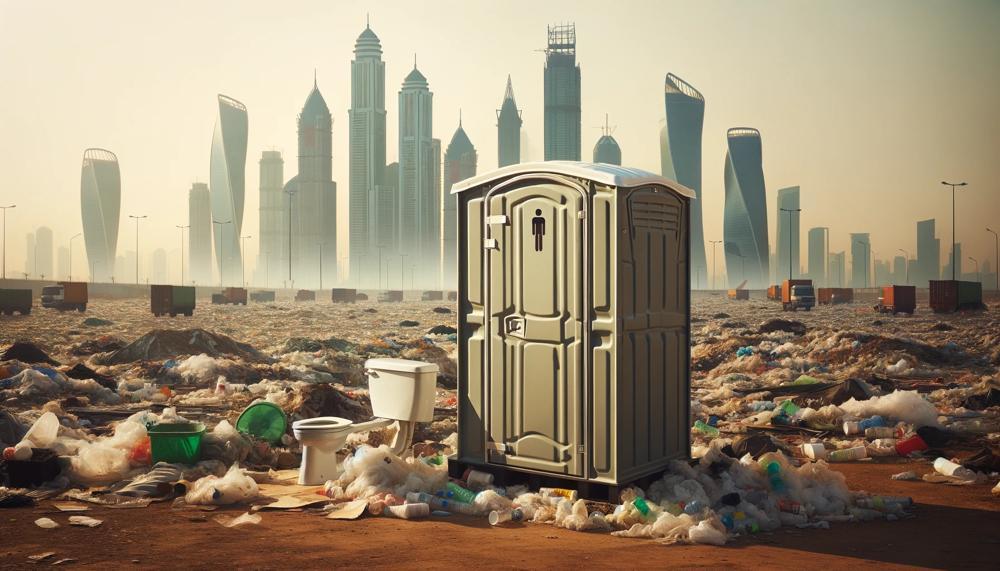Whether you’re a seasoned camper, event organizer, or simply curious about off-grid living, handling waste from portable toilets is a crucial skill that often goes unnoticed – until it’s too late.
In this article, we delve into the world of waste management in a way that’s informative, straightforward, and, believe it or not, somewhat entertaining. We’ll uncover:
- The Environmental Impact: Understand why disposing of human waste correctly is vital for protecting our environment.
- Step-by-Step Guide: A clear, no-nonsense guide on how to dispose of waste safely and effectively.
- Health and Safety Tips: Learn about the health risks associated with improper disposal and how to avoid them.
- Regulations and Best Practices: Stay informed about the legalities and ethical considerations in different regions.
Get ready to embark on a journey of responsible waste disposal, where we promise to keep things light, engaging, and most importantly, educational.
Contents
How Do Portable Toilets Work?
As an alternative term for confined cubicles without plumbing or sewage connections, porta-potties are portable toilets. To operate, they flush waste into a holding tank that is filled with chemicals that decompose waste, eradicate bacteria, and lessen odor.Portable toilets may draw water from the chemicals in the holding tank or from a covert tank within the toilet.
This is how portable restrooms function:
- Fill the holding tank: The holding tank of a portable toilet is typically 60 gallons. You cYou cYou can fill it with both chemicals and water. Certain toilets conceal the waste using a blue dye that changes color as the tank fills up.
- Use the flush feature on portable toilets.
- Empty the tank: A qualified sanitation crew will empty the tank once it is full. To suction the waste into a tanker truck, they can attach a vacuum to the tank.
- Refill: The group will add chemicals and fresh water to the device.
Construction sites, festivals, and outdoor gatherings are common places to utilize portable restrooms.
Cleaning Your Portable Toilet
Keeping a portable loo spick and span isn’t just about wiping down surfaces; it’s an art. Here’s how to tackle it like a pro, ensuring every nook and cranny is not just visibly clean but hygienically safe too.
| Task | How To | Tips |
| Wear Protective Gear | Gloves, goggles, mask | Prevents direct contact with harmful substances |
| Empty Waste Tank | Use pump/vacuum | Do it efficiently and safely |
| Clean Surfaces | Brush/sponge + disinfectant | Focus on user contact points |
| Select Cleaners | Eco-friendly, non-toxic | Good for the loo and the environment |
| Odour Control | Deodorizers, ventilation | Keeps the loo smelling fresh |
| Water Levels | Regular checks | Essential for flush system |
| Exterior Maintenance | Clean/wipe down | Keeps the loo inviting |
| Troubleshooting | Address leaks, clogs | Prevents bigger issues |
Remember, a clean portable toilet isn’t just about aesthetics; it’s about health, safety, and respecting the environment.
Sanitary Precautions for Disposing of Human Waste from Portable Toilets
Disposing of human waste from portable toilets calls for more than just a keen nose and a stout heart; it demands adherence to strict sanitary precautions to safeguard health and maintain cleanliness.
Here’s the nitty-gritty on doing it right:
Suit Up for Safety
Before diving into the task, clothe yourself in protective gear. Gloves are a must; they form a barrier between you and the waste, keeping harmful pathogens at bay.
A face mask is equally important to avoid inhaling any noxious fumes.
Seal and Secure
The waste container must be properly sealed and secured.
This step is crucial to prevent leaks and spills during transport, which could be both hazardous and foul-smelling.
Transport Wisely
Utilise a designated vehicle for transporting the waste. This is key in avoiding cross-contamination with non-waste materials.
Dispose According to Regulations
Adherence to local disposal regulations is paramount. These may dictate the disposal at specific facilities like wastewater treatment plants or composting facilities.
Wash Hands Thoroughly
Post-disposal, a thorough handwash with soap and water is non-negotiable. This simple act is one of the most effective ways to prevent the spread of diseases.

Clean and Disinfect the Portable Toilet
After each use, ensure the portable toilet is cleaned and disinfected. This helps maintain a hygienic environment for the next user.
Designate a Disposal Area
Choose a well-ventilated, secure area for waste container disposal, well away from food or water sources. Implementing a waste management plan is also advisable for efficient disposal.
Compliance Table
| Activity | Precaution | Reason |
|---|---|---|
| Handling | Gloves, Mask | Prevent direct contact and inhalation of harmful substances |
| Transporting | Sealed Containers, Designated Vehicle | Avoid leaks and cross-contamination |
| Disposing | Follow Local Regulations | Ensure environmental and health safety |
| Post-disposal | Handwashing | Prevent disease spread |
| Cleaning | Disinfectant Use | Maintain hygiene and safety |
What Chemicals Should Be Used For Portable Toilets?
The chemicals frequently utilised in portable toilets are indispensable for ensuring these facilities are sanitary and safe for users, particularly at bustling events or on construction sites.
| Chemical | Function | Benefits |
| Sodium Hypochlorite | Disinfectant | Kills germs and controls odour |
| Calcium Hypochlorite | Solid Waste Breakdown | Helps decompose solid waste material |
| Quaternary Ammonium Compounds (QACs) | Sanitizer | Aids in waste decomposition and sanitation |
| Formaldehyde | Bacterial Growth Inhibitor | Prevents the growth of bacteria |
The strong germicide sodium hypochlorite, the main component of many liquid bleaches, attacks germs head-on, guaranteeing a germ-free workplace and battling the odors that are unavoidable in such settings. Tablets containing calcium hypochlorite are essential for dissolving solid waste and facilitating a more streamlined and sanitary disposal procedure.
Because of their superior sanitizing abilities, QACs help to break down waste more effectively and maintain the highest level of hygienic conditions for portable restrooms. Even though formaldehyde is contentious, it is used sparingly, mostly to prevent bacterial development, which greatly improves the facilities’ general cleanliness.
These substances, chosen for their distinct functions, highlight how crucial it is to choose the appropriate mixtures to preserve the use and cleanliness of portable toilets. Despite the apparent simplicity of home bleach as a replacement, the carefully designed combination of these substances ensures maximum effectiveness without compromising the environment or the toilet’s parts.
The development of chemicals used in portable toilets reflects our march towards a future where sustainability is paramount, with an increasing focus on environmentally friendly options that still satisfy strict safety and sanitation regulations.
Conclusion
In order to maintain environmental health and personal hygiene during outdoor activities and events, managing waste from portable toilets is a silent hero.
This indispensable manual has shed light on the complexities surrounding the ostensibly straightforward activity, highlighting its significance in preserving hygiene and protecting the environment. The path from comprehending the environmental effect to becoming an expert in the methodical disposal process—which is interspersed with health and safety advice and regulatory compliance—reveals a convoluted web of factors that need to be carefully traversed.
It is not only a practical issue to ensure the appropriate treatment of human waste; it is a commitment to environmental preservation and public health protection. With an understanding of the inner workings of portable toilets, the need of routine maintenance, and the specific procedures for the safe transportation and disposal of waste, people and organizers may approach this duty with assurance and accountability.
This book is like a lighthouse, helping us navigate the subtleties of an often-overlooked but essential chore that ensures a clean, safe, and ecologically responsible outdoor experience.





